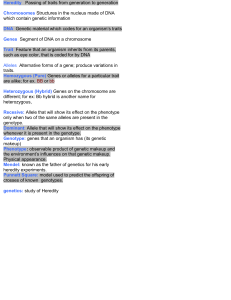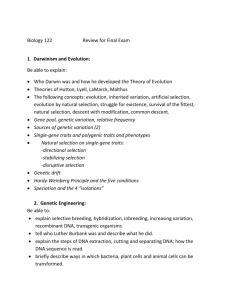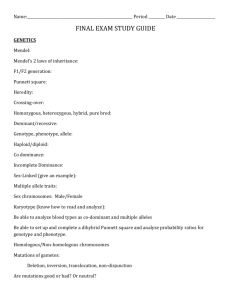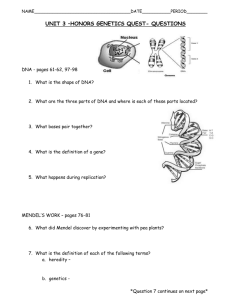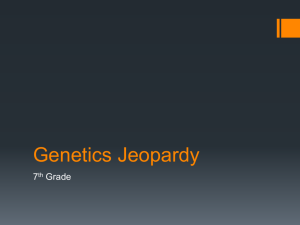Name: Heredity Review Sheet 1. Who is Gregor Mendel and what is
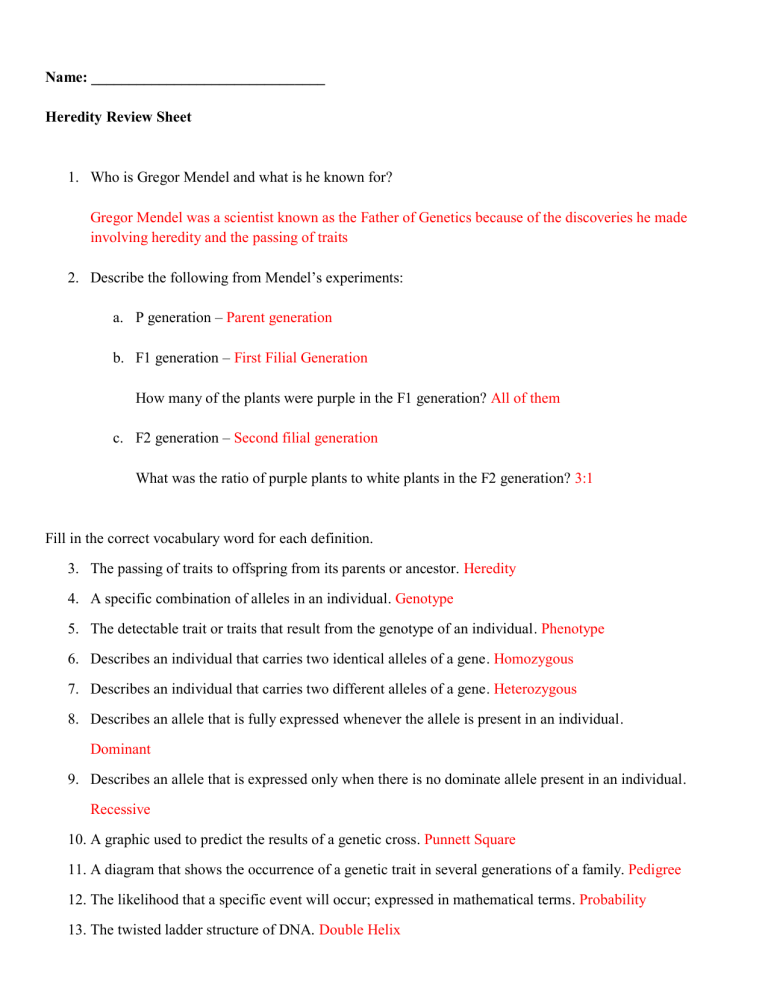
Name: _______________________________
Heredity Review Sheet
1.
Who is Gregor Mendel and what is he known for?
Gregor Mendel was a scientist known as the Father of Genetics because of the discoveries he made involving heredity and the passing of traits
2.
Describe the following from Mendel’s experiments: a.
P generation – Parent generation b.
F1 generation – First Filial Generation
How many of the plants were purple in the F1 generation? All of them c.
F2 generation – Second filial generation
What was the ratio of purple plants to white plants in the F2 generation? 3:1
Fill in the correct vocabulary word for each definition.
3.
The passing of traits to offspring from its parents or ancestor. Heredity
4.
A specific combination of alleles in an individual. Genotype
5.
The detectable trait or traits that result from the genotype of an individual. Phenotype
6.
Describes an individual that carries two identical alleles of a gene. Homozygous
7.
Describes an individual that carries two different alleles of a gene. Heterozygous
8.
Describes an allele that is fully expressed whenever the allele is present in an individual.
Dominant
9.
Describes an allele that is expressed only when there is no dominate allele present in an individual.
Recessive
10.
A graphic used to predict the results of a genetic cross. Punnett Square
11.
A diagram that shows the occurrence of a genetic trait in several generations of a family. Pedigree
12.
The likelihood that a specific event will occur; expressed in mathematical terms. Probability
13.
The twisted ladder structure of DNA. Double Helix
Dominant = B, brown eyes
Complete the Punnett Square & table
for a homozygous recessive parent crossed with a heterozygous parent
Recessive = b, blue eyes
Complete the Punnett Square & table for two heterozygous parents
Possible
Genotypes
Bb
Possible
Phenotypes
Brown
Probability
50% bb Blue 50%
DNA is made up for 4 nucleotide bases.
These bases are:
Adenine, Thymine, Cytosine, Guanine
The bases pair up specifically, Adenine pairing with Thymine and
Guanine pairing with Cytosine.
Possible
Genotypes
BB
Possible
Phenotypes
Brown
Probability
25%
Bb bb
Brown
Blue
50%
25%
The steps of DNA replication are:
1.
Two DNA strands separate
2.
Nucleotides match up with the DNA base by base
3.
Two identical DNA molecules are created
A mutation is any change to DNA.
Mutations can have little to no effect or a significant effect.
A mutation that effects the normal function of a cell is called a genetic disorder . These can be inherited , like
Tay-sachs disease, sickle cell disease, or cystic fibrosis.
These can also result from mutations that occuring during a person’s lifetime. The most common example of this is cancer .
Modern Genetics:
Describe selective breeding:
People select and breed parent organisms to pass on particular traits to the offspring
Describe genetic engineering:
The process in which a sequence of DNA from an organism is first isolated, then inserted into the DNA of another organism
What is the resulting organism called?
Genetically Modified
What are two uses for DNA technology?
1. Solving crimes
2. Locating missing persons
3. Studying genomes
Define genome: all the genetic material in an organism
Define cloning: a technique that uses technology to copy these sequences of DNA, or genomes


